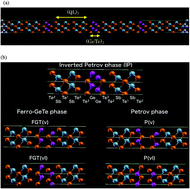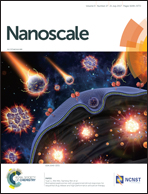Resistive switching mechanism of GeTe–Sb2Te3 interfacial phase change memory and topological properties of embedded two-dimensional states†
Abstract
A theoretical study of an interfacial phase change memory made of a GeTe–Sb2Te3 superlattice with W electrodes is presented to identify the high and low resistance states and the switching mechanism. The ferro structure of the GeTe layer block in the Te–Ge–Te–Ge sequence can be in the low resistance state only if the SET/RESET mode consists of a two step dynamical process, corresponding to a vertical flip of the Ge layer with respect to the Te layer, followed by lateral motion driven by thermal relaxation. The importance of spin–orbit coupling at the GeTe/Sb2Te3 interface to the “bias polarity-dependent” SET/RESET operation is shown, and an analysis of the two-dimensional states confined at the GeTe/Sb2Te3 interface inside the resistive switching layer is presented. Our results allow us to propose a phase diagram for the transition from a topologically nontrivial to a trivial gap state of these two-dimensional compounds.



 Please wait while we load your content...
Please wait while we load your content...